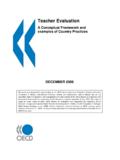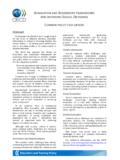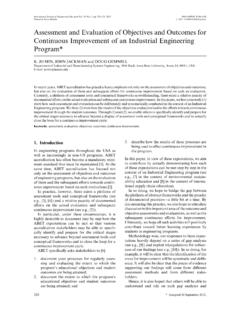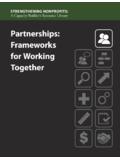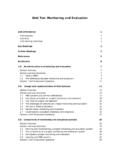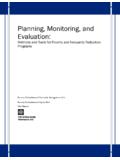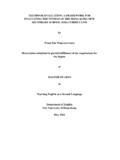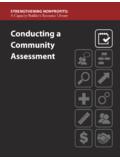Transcription of 2017 to 2018 teacher assessment frameworks at …
1 teacher assessment frameworks at the end of key stage 2 For use in the 2017 to 2018 academic yearNational curriculum assessmentsKey stage 2[BLANK PAGE] Page 1 of 9 Changes for 2017 to 2018 The Primary assessment in England public consultation, which closed in June 2017, heard strong support for the proposal to move to a more flexible approach to the assessment of English writing, and to do this quickly. The Standards and Testing Agency (STA) also conducted an evaluation of the interim teacher assessment frameworks during spring 2017, working with teachers and other educational experts.
2 In response, we have made changes to the frameworks for use in 2017 to 2018. English writing For 2017 to 2018, we have introduced revised teacher assessment frameworks in English writing only, which include: A more flexible approach teachers can now use their discretion to ensure that, on occasion, a particular weakness does not prevent an accurate judgement of a pupil s attainment overall being made. The overall standard of attainment, set by the pupil can statements, remains the same. Revised pupil can statements a greater emphasis on composition, while statements relating to the more technical aspects of English writing (grammar, punctuation and spelling) are less prescriptive.
3 All changes are in line with the attainment targets for the key stage 2 programme of study. Guidance We have also updated the guidance within the frameworks to clarify the level of evidence required to support teachers judgements, including to make clear that: A pupil s work in the subject being assessed alone may provide sufficient evidence to support that judgement, although evidence should ideally include work in other curriculum subjects. Teachers may consider a single example of a pupil s work to provide sufficient evidence for multiple statements.
4 A pupil s work which demonstrates that they meet a standard is sufficient to show that they are working above preceding standards. When assessing science, there is no requirement to have evidence from the classroom that pupils have met statements relating to science content taught before the final year of the key stage. A school s own tests, in addition to statutory tests, can be used as evidence to support a judgement. Furthermore, a pupi l s answers to specific questions in any tests are acceptable forms of evidence to meet certain statements.
5 frameworks for English reading, mathematics and science The pupil can statements within the frameworks for English reading, mathematics and science are unchanged. The government response to the primary assessment consultation confirmed that we will remove the requirement for schools to report teacher assessment judgements in English reading and mathematics at the end of key stage 2 from the 2018 to 2019 academic year onwards. 2017 to 2018 will be the last year that these subject frameworks are used. The pupil can statements within the frameworks for science were evaluated and revised versions will be published for use from the 2018 to 2019 academic year.
6 Page 2 of 9 Guidance for teachers Main principles These frameworks should be used only to make a statutory teacher assessment judgement at the end of the key stage following completion of the key stage 2 curriculum. They should not be used to track progress throughout the key stage. The frameworks focus on certain key aspects of the core subjects for the specific purpose of statutory end -of-key stage assessment . They do not cover all of the content of the national curriculum. Pupils meeting the different standards within the frameworks will have a broader range of knowledge and skills than those being assessed, and these should be reported to parents.
7 The frameworks are not a formative assessment tool: they are not intended to guide individual programmes of study, classroom practice or methodology. Teachers should assess individual pieces of pupils work in line with their school s own assessment policy and not against the frameworks . At the end of the key stage, teachers should make a judgement against the frameworks based on their own assessments of pupils work. Teachers need to base their judgement on a broad range of evidence, which will come from day-to-day work in the classroom.
8 This should include work in curriculum subjects other than the one being assessed, although a pupil s work in that subject alone may provide sufficient evidence to support the judgement. Teachers may also consider a single example of a pupil s work to provide evidence for multiple statements. Teachers should be confident that pupils have met the standards preceding the one at which they judge them to be working. However, the y are not required to have specific evidence for that judgement. A pupil s work which demonstrates that they meet a standard is sufficient to show that they are working above preceding standards.
9 Each subject framework has either one or three standards of attainment containing pupil can statements upon which teachers will base their judgements. Teachers should follow the specific guidance for each subject. Qualifiers and examples Some of the statements within this framework contain qualifiers ( some , many and most ) to indicate the extent to which pupils should demonstrate the knowledge or skill required. Further guidance about making consistent judgements is available in STA s exemplification material.
10 Where qualifiers are used, they have consistent meaning: most indicates that the statement is generally met with only occasional errors; many indicates that the statement is met frequently but not yet consistently; and some indicates that the knowledge or skill is starting to be acquired and is demonstrated correctly on occasion, but is not yet consistent or frequent. Some of the statements contain examples. These do not dictate the evidence required, but show only how that statement might be met. Teachers should refer to the national curriculum to exemplify the statements, and can use STA s exemplification materials.










